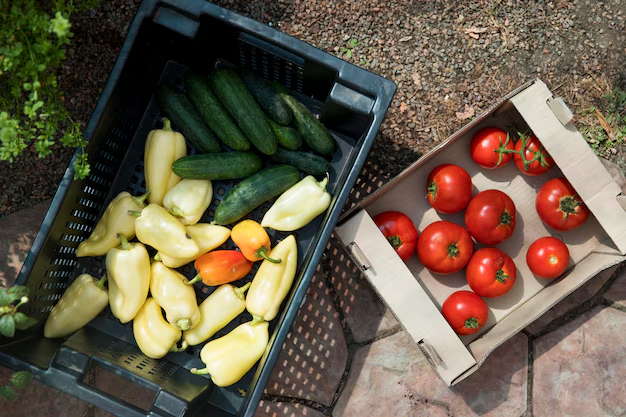Should You Refrigerate Tomatoes? The Ultimate Guide to Tomato Storage
Picture this: you return from the farmers' market with a bounty of ripe, juicy tomatoes, a staple in countless dishes worldwide. As you unload your groceries, a familiar dilemma resurfaces—is it okay to put tomatoes in the refrigerator? This simple question has sparked countless debates, and the answer isn't as straightforward as you might think. In this comprehensive guide, we'll explore the nuances of tomato storage, factoring in aspects like flavor, texture, and freshness to help you make informed decisions in your kitchen.
🍅 The Great Tomato Debate: Refrigerator or Countertop?
Why the Refrigerator Isn't Always Tomato-Friendly
To grasp the heart of the tomato refrigeration debate, it's essential to understand why some experts advise against refrigerating them. Refrigerators are known for their cool and moist environments, ideal for most perishables. However, tomatoes are a unique fruit. Their complex flavor profile and texture are sensitive to cold temperatures, which can alter their quality.
- Flavor Impact: Cold temperatures can mute the natural flavor compounds in tomatoes. This means your ripe tomato might lose its vibrant taste after a stint in the fridge.
- Texture Changes: Tomatoes exposed to cold can develop a mealy, grainy texture. The cell membranes break down, leading to an unappealing texture when bitten into.
When Refrigeration Is the Best Option
While the general guidance leans towards keeping tomatoes out of the fridge, there are circumstances where refrigeration is beneficial:
- Extending Shelf Life: If your tomatoes are very ripe and you’re not planning to use them immediately, refrigeration can slow down their ripening process and prevent spoilage.
- Halved or Cut Tomatoes: Once a tomato is cut, storing it in the refrigerator can prevent bacterial growth and maintain safety. Just ensure it's properly wrapped or sealed.
🍃 The Role of Ripeness: Tailoring Storage Techniques
Understanding Tomato Ripeness
Ripeness is a game-changer in determining how you should store tomatoes. Here's how to recognize the ripeness stages:
- Under-ripe: Hard with a consistent green hue. Best left on the countertop to ripen.
- Perfectly Ripe: Firm yet yielding to gentle pressure, and richly colored (red, orange, yellow, etc.).
- Over-ripe: Soft with a high risk of bruising. Refrigeration may be necessary to prolong usability.
Storing According to Ripeness
- Under-ripe Tomatoes: Keep them on the countertop away from direct sunlight to ensure even ripening. A paper bag can accelerate the process.
- Ripe Tomatoes: Use promptly for the best flavor. If immediate use isn’t in the cards, consider refrigeration, but allow them to return to room temperature before consumption to enhance flavor.
- Over-ripe Tomatoes: These should either be refrigerated or used in cooked preparations like sauces or soups.
🥫 Creative Uses for Tomatoes at Every Stage
Depending on your culinary plans, storing tomatoes correctly can open the door to countless delicious possibilities. Here’s how you can creatively use tomatoes at various stages:
- Under-ripe Creations: Slice them thin for a fried green tomato dish or pickle them for a tangy snack.
- Ripe Wonders: Perfect for fresh salads, salsas, or a classic caprese.
- Over-ripe Benefits: Ideal for simmering into a hearty tomato sauce, bruschetta topping, or adding a burst of flavor to soups.
🍽️ Practical Tomato Storage Tips for Maximum Freshness
General Storage Tips
- Avoid Plastic Bags: Tomatoes need to breathe. Storing them in plastic can trap moisture, leading to mold and rot.
- Stem Side Down: If storing on the counter, place them stem side down to reduce airflow and moisture loss.
- Monitor Moisture: Ensure any storage area is not overly moist as this can promote spoilage.
A Simple Guide to Tomato Preservation
To ensure your tomatoes maintain freshness and taste, follow this handy summary:
- 🌞 Cool, Dark, Dry: Store ripe tomatoes on the counter in a single layer to avoid bruising.
- 🥶 Emergency Refrigeration: For overripe tomatoes or leftovers, briefly refrigerate, but consume soon after returning to room temp.
- 🛢️ Think Ahead: Use tomatoes with any blemishes first to minimize waste.
Other Refrigerator Topics: Expanding Your Kitchen Knowledge
🍊 Fruits and Vegetables
As we've seen with tomatoes, storing fruits and vegetables can be a sensitive affair:
- Berries: More sensitive to moisture, they often fare well in the fridge, lined with a paper towel to absorb excess dampness.
- Citrus Fruits: While they can last longer at cooler temperatures, they may keep their flavor best on the counter for a week or two.
🧀 Dairy Dilemmas
With dairy, proper refrigeration is vital for safety:
- Cheese: While hard cheeses can sometimes be safely wrapped and stored in a cool pantry, most cheeses need refrigeration. Ensure they’re in a breathable wrap like parchment paper.
- Milk: Best kept in the fridge, ideally at the back where temperatures are most consistent.
⚖️ Striking a Balance: Tips for Efficient Kitchen Management
Creating an efficient kitchen also involves being strategic about your refrigerator use:
- Labeling: Use labels on food containers to keep track of dates and reduce waste.
- Organizing: Maintain designated areas in your fridge for different products to prevent cross-contamination and enhance airflow.
🚀 Key Takeaways for Tomato Enthusiasts
Here’s a visually distinct bullet-point list to summarize the key insights and actionable tips from this guide. Scan them quickly and make the most out of your tomatoes:
- 🍅 Ripeness Matters: Countertops are ideal for ripening tomatoes.
- ❄️ Short-term Refrigeration: Utilize for overripe or cut tomatoes only briefly.
- 🏷️ Storage Strategy: Avoid plastic bags; use stem-down storage for counter tomatoes.
- 🍽️ Use and Enjoy: Allow refrigerated tomatoes to return to room temp before use for the best flavor.
The question of whether to chill your tomatoes now comes with clarity. With this newfound understanding, you can elevate your culinary experience, ensuring your dishes shine with the freshest and most flavorful tomatoes possible. Bon appétit!
